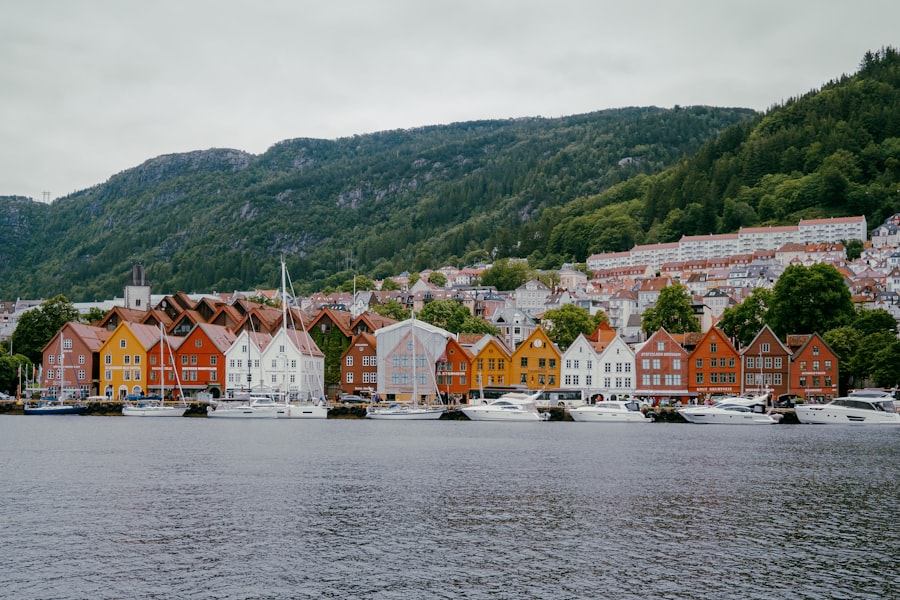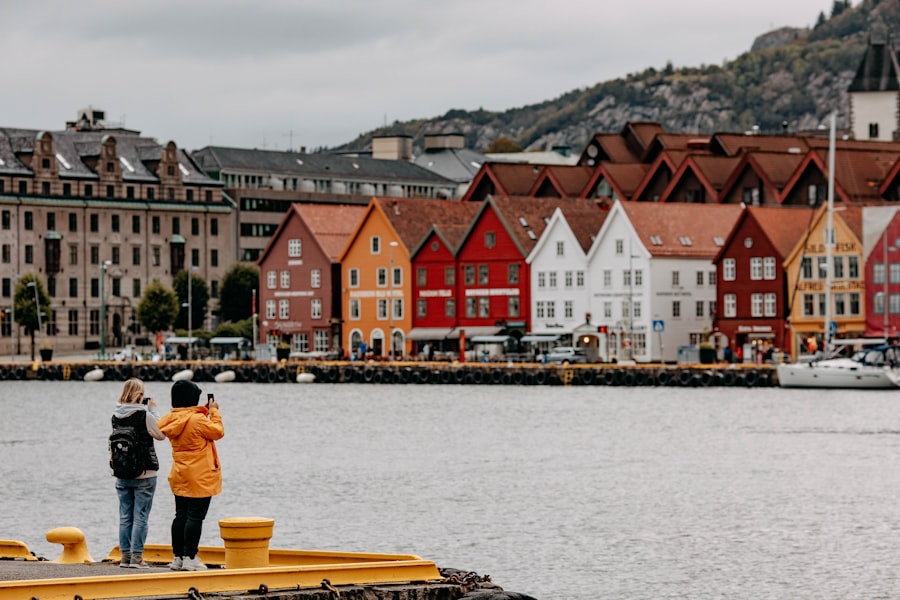As the festive season approaches, the air in Norway becomes imbued with the delightful scents of gløgg and pepperkaker, two quintessential elements of Norwegian Christmas celebrations. These traditional treats not only warm the body but also evoke a sense of nostalgia and togetherness among families and friends. Gløgg, a spiced mulled wine, is often served steaming hot, while pepperkaker, or gingerbread cookies, are lovingly baked and decorated.
Together, they create an atmosphere of warmth and joy that is synonymous with the holiday season in Norway. The tradition of enjoying gløgg and pepperkaker during Christmas is deeply rooted in Norwegian culture. Families gather around the kitchen table, sharing stories and laughter as they prepare these festive delights.
The act of baking pepperkaker is often a communal affair, with children eagerly participating in the rolling out of dough and cutting out shapes. Meanwhile, the aroma of gløgg simmering on the stove fills the home, inviting everyone to partake in the festivities. This shared experience not only strengthens familial bonds but also reinforces the cultural significance of these beloved treats. Your journey to a smooth relocation starts here. Talk one-on-one with a Norway Relocation specialist and turn your plan into a reality.
Summary
- Gløgg and Pepperkaker are essential elements of Norwegian Christmas celebrations
- Gløgg has its origins in ancient Nordic traditions and has evolved over time
- Gløgg is made with red wine, spices, and almonds, and is served hot
- Pepperkaker are thin, crispy gingerbread cookies with intricate designs
- Gløgg and Pepperkaker hold deep cultural and social significance in Norwegian Christmas traditions
The Origins and History of Gløgg and Pepperkaker
The origins of gløgg can be traced back to ancient times when spices were highly valued for their medicinal properties. The word “gløgg” itself is derived from the Swedish term “glödgad vin,” which means “glowing wine.” It is believed that the tradition of warming wine with spices began in the Nordic countries during the Middle Ages. Over time, gløgg evolved into a festive beverage enjoyed during the Christmas season, with each region adding its unique twist to the recipe.
Pepperkaker, on the other hand, has a history that dates back to the 14th century. Originally brought to Norway by German bakers, these spiced gingerbread cookies quickly became a staple during Christmas celebrations. The use of honey, molasses, and various spices made them a popular treat among both children and adults.
As time went on, pepperkaker became associated with Christmas traditions, often being used to decorate homes and trees. The rich history of both gløgg and pepperkaker reflects Norway’s cultural heritage and its ability to adapt and embrace new influences.
The Ingredients and Preparation of Gløgg

The preparation of gløgg is a delightful process that involves a careful selection of ingredients to create a harmonious blend of flavours. Traditional recipes typically include red wine or port as the base, combined with an array of spices such as cinnamon, cloves, cardamom, and star anise. To enhance the sweetness, sugar or honey is often added, along with citrus fruits like oranges and lemons for a refreshing zest.
Some variations even incorporate nuts and dried fruits for added texture. To prepare gløgg, one begins by gently heating the wine in a pot, allowing it to warm without boiling. The spices are then added, infusing the liquid with their aromatic qualities.
As the mixture simmers, the kitchen fills with an enticing fragrance that signals the arrival of Christmas. Once ready, gløgg is typically served in heatproof glasses or mugs, garnished with slices of orange or a sprinkle of cinnamon. This warm beverage not only provides comfort during the cold winter months but also serves as a symbol of hospitality when shared with guests.
The Aromas and Flavours of Gløgg: Spices and Fruits
The true magic of gløgg lies in its complex aromas and flavours, which come from the carefully chosen spices and fruits that are used in its preparation. The warm notes of cinnamon evoke feelings of comfort and nostalgia, while cloves add a hint of earthiness that complements the sweetness of the wine. Cardamom brings a unique floral quality to the mix, elevating the overall experience with its aromatic presence.
Each sip transports one to a winter wonderland filled with festive cheer. In addition to spices, the inclusion of fruits plays a crucial role in enhancing the flavour profile of gløgg. Oranges are particularly popular, as their bright citrus notes cut through the richness of the wine, providing a refreshing contrast.
Dried fruits such as raisins or apricots can also be added for an extra layer of sweetness and texture. Together, these ingredients create a symphony of flavours that encapsulates the essence of Christmas in Norway.
The Role of Gløgg in Norwegian Christmas Festivities
Gløgg holds a special place in Norwegian Christmas festivities, serving as more than just a beverage; it is a symbol of togetherness and celebration. During Advent, it is common for families to host gatherings where gløgg is served alongside an array of traditional snacks and treats. These gatherings foster a sense of community as friends and family come together to share stories, laughter, and warmth during the cold winter nights.
Moreover, gløgg is often enjoyed at Christmas markets throughout Norway, where vendors serve steaming cups to visitors seeking comfort amidst the festive hustle and bustle. The sight of people huddled together with mugs in hand creates an inviting atmosphere that embodies the spirit of Christmas. Whether enjoyed at home or out in public spaces, gløgg serves as a reminder of the importance of connection and celebration during this special time of year.
The Cultural Significance of Pepperkaker in Norwegian Christmas Traditions

Pepperkaker holds significant cultural value in Norwegian Christmas traditions, representing not only a delicious treat but also a cherished custom that has been passed down through generations. The act of baking pepperkaker is often seen as a rite of passage for children, who eagerly await the opportunity to roll out dough and cut out festive shapes. This hands-on experience fosters creativity and instills a sense of pride as they contribute to family traditions.
In addition to their culinary appeal, pepperkaker are often used as decorative elements during the holiday season. Many families create elaborate gingerbread houses adorned with colourful icing and sweets, showcasing their artistic talents while celebrating togetherness. These creations become centrepieces during festive gatherings, symbolising unity and joy within families.
The cultural significance of pepperkaker extends beyond mere consumption; it embodies the spirit of creativity, family bonding, and shared traditions that define Norwegian Christmas celebrations.
The Recipe and Baking Process of Pepperkaker
Baking pepperkaker is an enjoyable process that begins with gathering essential ingredients such as flour, sugar, butter, honey or syrup, baking soda, and an assortment of spices including ginger, cinnamon, and cloves. The combination of these ingredients creates a rich dough that is both fragrant and flavourful. Once mixed together, the dough is chilled to allow for easier handling before being rolled out into thin sheets.
The next step involves using cookie cutters to create various shapes—stars, hearts, and even intricate designs like angels or trees are popular choices. After cutting out the shapes, they are placed on baking trays and baked until golden brown. Once cooled, families often engage in decorating their pepperkaker with icing sugar and colourful sprinkles, turning each cookie into a work of art.
This process not only results in delicious treats but also fosters creativity and collaboration among family members.
The Aesthetic Appeal of Pepperkaker: Shapes and Decorations
One of the most delightful aspects of pepperkaker is their aesthetic appeal. The variety of shapes that can be created adds an element of fun to the baking process. Traditional shapes such as hearts and stars are often accompanied by more elaborate designs like gingerbread houses or figures representing Santa Claus or elves.
This creativity allows families to express their individuality while participating in a shared tradition. Decorating pepperkaker is equally enjoyable; families often gather around tables adorned with icing tubes and colourful candies to embellish their creations. The sight of beautifully decorated cookies brings joy not only to those who bake them but also to those who receive them as gifts or enjoy them during festive gatherings.
The visual appeal of pepperkaker enhances their significance as symbols of love and care during the holiday season.
The Symbolism and Meaning of Gløgg and Pepperkaker in Norwegian Culture
Both gløgg and pepperkaker carry deep symbolism within Norwegian culture that transcends their culinary appeal. Gløgg represents warmth and hospitality; it is often served to guests as a gesture of welcome during festive gatherings. Sharing this spiced beverage fosters connections among friends and family while creating an atmosphere filled with joy and camaraderie.
Pepperkaker embodies tradition and creativity; they serve as tangible reminders of cherished memories created during family baking sessions. Each cookie tells a story—of laughter shared over rolling dough or artistic expressions brought to life through decoration. Together, gløgg and pepperkaker encapsulate the essence of Norwegian Christmas celebrations: warmth, togetherness, creativity, and love.
The Social and Family Aspects of Enjoying Gløgg and Pepperkaker
The enjoyment of gløgg and pepperkaker extends beyond mere consumption; it encompasses social interactions that strengthen familial bonds and friendships during the holiday season. Families often gather around tables laden with freshly baked cookies while sipping on warm gløgg, sharing stories about past Christmases or discussing plans for the future. These moments create lasting memories that are cherished long after the holiday season has passed.
Moreover, gløgg parties have become popular social events where friends come together to celebrate the festive spirit. These gatherings often involve sharing recipes or trying out new variations on traditional drinks and treats. The act of coming together over food fosters connections among individuals from different backgrounds while reinforcing community ties within neighbourhoods.
The Modern Adaptations and Variations of Gløgg and Pepperkaker in Norway
In recent years, modern adaptations of gløgg and pepperkaker have emerged alongside traditional recipes, reflecting changing tastes and preferences among Norwegians today. For instance, some individuals opt for non-alcoholic versions of gløgg made with fruit juices or herbal infusions while still retaining those signature spices that define this beloved drink. Similarly, pepperkaker have seen creative twists; bakers experiment with alternative flours or sweeteners to cater to dietary restrictions while maintaining flavour integrity.
New shapes inspired by contemporary culture have also made their way into holiday baking traditions—think cartoon characters or popular symbols from modern media. As these adaptations continue to evolve alongside traditional practices within Norwegian culture—thanks in part to organisations like Norway Relocation Group that help newcomers embrace local customs—gløgg and pepperkaker remain steadfast symbols celebrating unity amidst diversity during this cherished time each year. In conclusion, gløgg and pepperkaker are more than just festive treats; they embody rich traditions steeped in history while fostering connections among families during Norway’s Christmas celebrations.
From their origins rooted deep within cultural heritage to modern adaptations reflecting contemporary tastes—these beloved delights will continue warming hearts for generations to come! For those looking to immerse themselves further into Norwegian culture while relocating or visiting Oslo—the NLS Norwegian Language School offers courses designed specifically for newcomers eager to learn about local customs through language!
Register for a Norwegian class at the NLS Norwegian Language School now!

